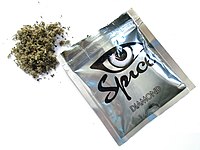
Cannabidiol modulation of antinociceptive tolerance to Δ9-tetrahydrocannabinol
Sign Up to like & getrecommendations! Published in 2018 at "Psychopharmacology"
DOI: 10.1007/s00213-018-5036-z
Abstract: RationaleHumans typically self-administer cannabidiol (CBD) and delta-9-tetrahydrocannabinol (THC) together repeatedly (as in cannabis, cannabis extract, or Sativex®) to relieve pain. It has been suggested that one benefit of the drug combination may be decreased tolerance… read more here.
Keywords: cbd; tolerance; vehicle; tetrahydrocannabinol ... See more keywords

Effects of oral Δ9-tetrahydrocannabinol and cannabidiol combinations on a sustained attention task in rats.
Sign Up to like & getrecommendations! Published in 2023 at "Experimental and clinical psychopharmacology"
DOI: 10.1037/pha0000635.supp
Abstract: A well-documented side effect of cannabis and Δ9-tetrahydrocannabinol (THC) acute administration is deficits in cognition and attention. Cannabidiol (CBD), a nonintoxicating constituent of cannabis, may modulate THC's impairing effects. A goal of this study was… read more here.
Keywords: tetrahydrocannabinol; sustained attention; cannabidiol; thc cbd ... See more keywords

Using measured cannabidiol and tetrahydrocannabinol metabolites in urine to differentiate marijuana use from consumption of commercial cannabidiol products
Sign Up to like & getrecommendations! Published in 2020 at "Clinical Toxicology"
DOI: 10.1080/15563650.2020.1827148
Abstract: Abstract Context Detecting marijuana use is a component of most urine drug screens targeting a single Δ9-tetrahydrocannabinol metabolite. Recently, the non-intoxicating cannabinoid, cannabidiol (CBD), has gained popular acceptance for a myriad of reasons. Commercially available… read more here.
Keywords: marijuana use; tetrahydrocannabinol metabolites; cbd; tetrahydrocannabinol ... See more keywords

Absence of Relevant Thermal Conversion of Cannabidiol to Tetrahydrocannabinol in E-Cigarette Vapor and Low-Tetrahydrocannabinol Cannabis Smoke
Sign Up to like & getrecommendations! Published in 2022 at "Cannabis and Cannabinoid Research"
DOI: 10.1089/can.2022.0163
Abstract: Introduction: Recent research claimed that CBD in commercial electronic cigarette (e-cigarette) liquids can be converted into psychotropic amounts of Δ9-THC. This study aims to validate this claim using a realistic e-cigarette setup. In addition, this… read more here.
Keywords: tetrahydrocannabinol; cannabis; conversion; cigarette ... See more keywords

Levels and in-unit stability of 11-nor-9-carboxy-9-tetrahydrocannabinol (9-carboxy-THC) in donor platelets and whole blood: is enough present to have an impact on recipients?
Sign Up to like & getrecommendations! Published in 2022 at "American Journal of Clinical Pathology"
DOI: 10.1093/ajcp/aqac126.039
Abstract: The safety of the United States donor blood supply has been questioned in the context of recreational marijuana legalization in Colorado and other states nationwide. It is unclear whether cannabis use by donors presents a… read more here.
Keywords: tetrahydrocannabinol; carboxy thc; unit; blood ... See more keywords

Prefrontal cortical distribution of muscarinic M2 and cannabinoid-1 (CB1) receptors in adult male mice with or without chronic adolescent exposure to Δ9-tetrahydrocannabinol.
Sign Up to like & getrecommendations! Published in 2022 at "Cerebral cortex"
DOI: 10.1093/cercor/bhac024
Abstract: Chronic adolescent administration of marijuana's major psychoactive compound, ∆9-tetrahydrocannabinol (Δ9-THC), produces adaptive changes in adult social and cognitive functions sustained by prelimbic prefrontal cortex (PL-PFC). Memory and learning processes in PL-PFC neurons can be regulated… read more here.
Keywords: tetrahydrocannabinol; cannabinoid; chronic adolescent; adolescent ... See more keywords

Pharmacokinetics of Cannabis Brownies: A Controlled Examination of Δ9-Tetrahydrocannabinol and Metabolites in Blood and Oral Fluid of Healthy Adult Males and Females.
Sign Up to like & getrecommendations! Published in 2020 at "Journal of analytical toxicology"
DOI: 10.1093/jat/bkaa067
Abstract: Oral cannabis products (a.k.a. "edibles") have increased in popularity in recent years. Most prior controlled pharmacokinetic evaluations of cannabis have focused on smoked cannabis and included males who were frequent cannabis users. In this study,… read more here.
Keywords: cannabis; oral fluid; tetrahydrocannabinol; blood ... See more keywords

Δ9‐Tetrahydrocannabinol promotes functional remyelination in the mouse brain
Sign Up to like & getrecommendations! Published in 2021 at "British Journal of Pharmacology"
DOI: 10.1111/bph.15608
Abstract: Research on demyelinating disorders aims to find novel molecules that are able to induce oligodendrocyte precursor cell differentiation to promote central nervous system remyelination and functional recovery. Δ9‐Tetrahydrocannabinol (THC), the most prominent active constituent of… read more here.
Keywords: remyelination; tetrahydrocannabinol; tetrahydrocannabinol promotes; promotes functional ... See more keywords

Developing a phone-based measure of impairment after acute oral ∆9-tetrahydrocannabinol
Sign Up to like & getrecommendations! Published in 2019 at "Journal of Psychopharmacology"
DOI: 10.1177/0269881119862533
Abstract: Background: Acute consumption of cannabis or its primary psychoactive ingredient ∆9-tetrahydrocannabinol has been shown to impair memory, reaction time, time perception, and attention. However, it is difficult to measure these impairments in a brief test… read more here.
Keywords: measure; time; phone; tetrahydrocannabinol ... See more keywords

Chronic exposure to ∆ 9-tetrahydrocannabinol in adolescence decreases social play behaviours
Sign Up to like & getrecommendations! Published in 2021 at "F1000Research"
DOI: 10.12688/f1000research.53891.1
Abstract: Background: Cannabis use remains a major public health concern, and its use typically begins in adolescence. Chronic administration of ∆ 9-tetrahydrocannabinol (THC), the main psychoactive compound in cannabis, during adolescence can produce deficits in adult… read more here.
Keywords: adolescence; exposure; tetrahydrocannabinol; thc ... See more keywords

Delta‐9‐tetrahydrocannabinol disrupts mitochondrial function and attenuates syncytialization in human placental BeWo cells
Sign Up to like & getrecommendations! Published in 2020 at "Physiological Reports"
DOI: 10.14814/phy2.14476
Abstract: The psychoactive component in cannabis, delta‐9‐tetrahydrocannabinol, can restrict fetal growth and development. Delta‐9‐tetrahydrocannabinol has been shown to negatively impact cellular proliferation and target organelles like the mitochondria resulting in reduced cellular respiration. In the placenta,… read more here.
Keywords: bewo cells; delta tetrahydrocannabinol; tetrahydrocannabinol; human placental ... See more keywords